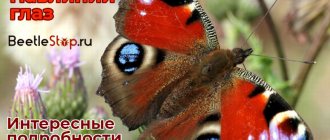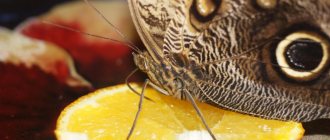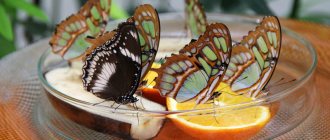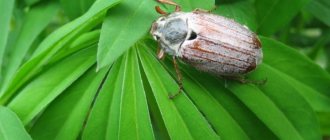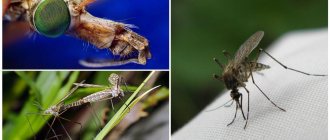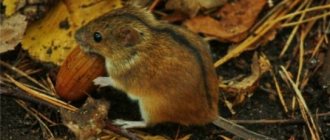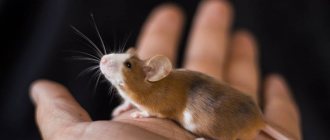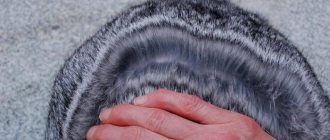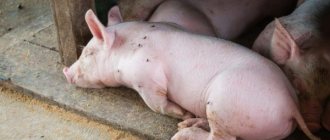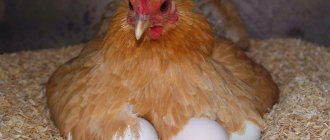The most beautiful representatives of the insect kingdom are butterflies. Most of them live a short life, from a few days to several months, but some, such as lemongrass, can live for almost a year or even more. Many species of lepidoptera die in the fall, but some of them manage to hide from severe frosts. Where and how butterflies and their pupae overwinter is not much different from the overwintering of other insects - these are cracks, crevices, heaps of branches, tree roots. And there are also migratory ones, for example burdocks, which, like birds, fly away for the winter where it is warm.
The structure and lifestyle of butterflies
Among invertebrates, butterflies are distinguished by their complex body structure and attractive appearance. The body of Lepidoptera consists of a head, abdomen, proboscis, chest, antennae, two pairs of wings and three pairs of legs. Butterflies are distinguished by their natural beauty. The wings of these insects have different colors and patterns. The coloration of Lepidoptera can be of two types: optical (depending on the refraction of light) and pigmentary.
During their life, these insects go through several transformations. The diet of Lepidoptera includes only liquid food, which they can consume thanks to their proboscis. Most often it is pollen, flower nectar, and tree sap. They can also take nutrient liquid from puddles and plant leaves.
Some Nymphalidae insects need additional moisture and various microelements. For this reason, they can use the excrement and urine of large animals, wet clay, and human sweat. Science knows for certain that butterflies from the Amazon rainforest drink the tears of turtles and crocodiles. But the males of some species of cutworms use animal blood to maintain vital energy.
The wings of Lepidoptera consist of two pairs, which have a membranous structure and are penetrated by longitudinal and transverse veins. The color can be very different, which is very important for protecting insects. Multi-colored wings make it easy to blend into the environment to hide from predators.
Life expectancy depends on the habitat, type and size of lepidoptera. The smallest butterflies can enjoy the beauty of this planet for just a few days. Tropical forests are home to some of the largest species of Lepidoptera, with a lifespan of 2-6 months. Representatives of middle latitudes can live for 1 month, and representatives of northern latitudes - up to 2 years.
Lepidoptera can be found on almost all continents of the planet, but with the exception of Antarctica. Most butterflies live on the islands of the Pacific Ocean, in Greenland, as well as in the highlands of the Himalayas. Lepidoptera belong to the category of cold-blooded insects. They are able to regulate their own body temperature, taking heat from the outside or gradually releasing it to the environment. Zoologists have characterized butterflies as insects with a full cycle of transformation, since their development goes through all stages: egg → caterpillar → pupa → adult.
Where and how to catch butterflies and in what conditions to store them?
We've all had the opportunity to see how harmless butterfly collecting is these days. But our entomologist, who spent time in a Madagascar prison filled with germs and stench, got off lightly.
Every year, at least 30 people die trying to catch a Brazilian butterfly called Morpho. It is found only in the jungle on the tops of huge trees. The flimsy devices often fail to support nature lovers, and they fall down from a height of 40 meters.
Report by Svetlana Kostina.
Nikolai Petrov keeps exhibits from his collection in an ordinary refrigerator. Butterflies, he explains, need to be stored at low temperatures. Over 27 years, about 2 thousand copies accumulated on dusty shelves in his apartment. For a collector, this beauty is priceless, but its market value today is several tens of thousands of dollars.
The entire geography of the world on one shelf. For example, Nikolai caught this Aurora himself with a huge net in the Krasnoyarsk Territory. And the entomologist received the colored and rainbow Urania Madagascar by mail from a foreign colleague. By the way, exchange is one of the most popular ways to diversify your collection.
The dried butterfly feels like a leaf from a herbarium. Before giving it a marketable appearance, Nikolai soaks it and then puts it in wet sand for several days.
This work is almost jewelry. In the hands of an entomologist, right before our eyes, the beauty spreads her wings. For work, the instruments are similar to surgical ones: thin tweezers and special entomological pins - as thin as possible.
Experts value this large specimen at $50. The cost of such butterflies directly depends on the size. Moreover, the count is in millimeters. For a slightly larger exhibit you will have to pay 1000 dollars. But Nikolai does not sell his beauties, but exhibits them at the Zoological Museum of Kazan University, where he works. There is a whole stand here, assembled from his exhibits, which he brought from numerous trips.
The life of a butterfly is fleeting. In nature, it lives only about 2 weeks. But entomologists have proven that you can enjoy the beauty of a butterfly for much longer. For example, this collection is over 100 years old.
They were brought to Kazan under Nicholas II. Moreover, over time, Indonesian butterflies have not lost either their shape or color. Entomologists say that this beauty can be enjoyed for at least another 100 years. And Nikolai Petrov is already in full swing preparing for the summer. In the forest not far from his home, he plans to breed Apollo butterflies, rare butterflies for Tatarstan.
Presenter: The famous traveler and entomologist Viktor Sinyaev volunteered to help us create our own collection of butterflies, if anyone suddenly had such a desire. Victor Vasilievich, good afternoon. Well, you have a live butterfly on your chest, such a collection is probably very short-lived after all?
Guest: Yes, of course, a butterfly, if it flies, it will soon turn to fluff and dust. Now, in order for her not to be and remain in her virgin beauty, she needs, as entomologists say, to kill her, or put her to sleep.
Host: Is it possible to catch all butterflies in the world without restrictions and are there any areas where it is definitely not possible?
Guest: Of course, you cannot collect butterflies in a national park, because the regime of national parks implies criminal liability, which we sometimes see in the news, and secondly, there are so-called Red Books or lists of rare species that are also under protection.
Host: What equipment should you use to go hunting, such a unique one? Is it only with a net, as many people think?
Guest: The net is not enough. You also need a box where you will place these butterflies. They can be pinned directly onto a needle, then the quality of the butterflies increases and usually a person places them in a paper bag, folds the wings and a special triangle, removes them, closes them and puts them in a box. And in the evening he signs a label on each triangle. I’ll even tell you that among serious butterfly collectors, a butterfly without a label is nothing, no matter how beautiful, large or even rare it is. If it doesn't carry information, it's worthless.
The butterfly is pinned on a needle and there is a label below, which, I repeat once again, carries all the information.
Host: Should a caught butterfly be killed immediately, or should it be planted in a cage and it flutters there?
Guest: It depends on the goal you are pursuing. If you collect butterflies, then of course, daytime butterflies only need to press down on its chest and you break its backbone and it will no longer fly. And you put it in a bag and it waits there for its time. If you are engaged in breeding, as I do, I place some females in a kind of cage. And butterflies lay eggs there. Then I release the butterfly, it is not needed, and from the eggs I will get specimens of the same virgin beauty. You see, the butterfly is alive, now this butterfly is nocturnal. Now the lights are on, and she, of course, is waiting until dusk comes in order to fly.
Host: So you brought the caught butterfly home, what to do with it, how to process it?
Guest: You definitely need to dry them, otherwise they will spoil. You bring the butterflies dried in bags home and also place them in a dry place and just add mothballs so that there are no bugs or anything else.
The principle of suspended animation of lepidoptera
Many species of butterflies spend the winter in the egg stage. The crimson silkworm waits in the form of a caterpillar for the warm season, but this is rather an exception to the rule. Most Lepidoptera hibernate while in the pupal stage. Many of them are so hardy that they can spend the entire winter on a tree branch or other open area, without fear of frost and piercing wind.
Almost all caterpillars have a bright appearance, since in this way they demonstrate to enemies that they are inedible, while others camouflage themselves in the green part of plants. The duration of the life cycle directly depends on climatic conditions. In northern latitudes, caterpillars may go into diapause (fall asleep) until spring. In such a situation, development can take from 4 to 10 years. It is quite difficult to reproduce the full life cycle of these insects at home.
Some caterpillars prefer to choose secluded places in the bark of old trees, where they turn into pupae and wait for the onset of spring. In the adult stage, the following butterflies hibernate:
- Hives.
- Lemongrass.
- Painted lady.
They take cover with their own wings, hiding in a hollow tree or in the attic of a house.
Mourning butterflies are helped to avoid freezing by a special liquid that they independently produce. It contains various cryoprotectors that provide excellent protection against frost. The behavior of butterflies largely depends on the species and climatic conditions.
Even in closely related species of the same genus that live in different regions of the country, diapause occurs at different phases of development. For example, the first generation of burdock butterflies goes south in the fall, and the second generation returns back in the spring. Thanks to this, these lepidopterans disappear from view only during cold weather, and with the arrival of warmth they can again be observed in different regions of Russia.
Dangers of insects in winter
Most insects survive the winter cold at the pupal stage; the cocoon provides additional protection from frost and microorganisms. Some butterflies migrate from the cold to southern latitudes, where they safely survive the winter season. But the peacock's eye, just like the urticaria and lemongrass, awaits the arrival of spring in its habitats. He hides in a pile of autumn leaves and plunges into suspended animation.
Global warming has a negative impact on wildlife. Increasingly, thaws occur in the middle of winter with an average daily plus temperature of up to 10 °C. Because of the heat, insects and animals wake up early. In winter, you can see a peacock butterfly emerging from a hollow or other shelter. This is a disastrous awakening. The insect wastes energy in vain, and it may not be able to find another suitable place to continue hibernation.
Information. For a successful winter, butterflies need dry shelter. In a humid environment, they are attacked by deadly fungal infections.
Not all butterflies will be able to survive the cold season. There are several reasons for the death of insects:
- They often starve to death when they cannot store enough energy in the fall.
- They become food for birds or animals. Small rodents, most often mice, look for food in hollows, outbuildings, and forest litter in winter.
- They die from various infections.
Waking up in the spring after wintering, peacock butterflies look for any food sources - primroses, dandelions. They flutter over flowers, collecting nectar, looking for juice that appears on the bark of trees. Males occupy sunny areas and wait for overwintered females to appear for mating and procreation.
Choosing a place for wintering
Many butterflies lay eggs in the summer to produce a new generation and then die. But there are real long-livers. If you need to find out what winter butterflies live in Russia, then you should turn to trusted sources. Wikipedia states that lemongrass, urticaria and burdocks live on the territory of the Russian Federation, which simply sleep in winter. They climb into hollow trees, various crevices and wrap themselves in their wings. Many insects prefer to prepare thoroughly for wintering, which is why they try to find a reliable place closer to human habitation.
To understand where butterflies go in winter, you need to take into account that science knows the migration of lepidopterans, which, huddled in flocks of up to 1 million individuals, fly to warmer climes in the fall. But even numerous experiments by scientists could not explain how exactly these creatures find the right path. The thing is that they have a primitive nervous system, which is why they cannot navigate by the sun.
The caterpillars of some species of bluebirds prefer to live inside large anthills. Worker ants carry insects to their nest. In such conditions, the caterpillars live until they pupate and become an adult butterfly. All this time, the ants not only feed the caterpillar, but also try to do everything possible to protect it from various dangers. This happens for the reason that the insect makes the same sounds as the queen ant.
How the peacock butterfly overwinters: revealing the secrets of the insect
A striking representative of the nymphalid family, the peacock eye can be seen in early spring. It is found in parks, gardens, forests and meadows. This species is considered one of the most beautiful in the world. Red-brown wings with bright eyes attract close attention. Watching a fluttering moth, you want to know about its lifestyle. No less interesting is how the peacock butterfly winters?
Rules for keeping at home
Butterflies prefer to winter exclusively in a cool place . Otherwise, they may not survive until spring. This is due to the fact that during hibernation, lepidoptera's metabolism accelerates, which is why the aging process proceeds much faster. Peacock butterflies are common in Russia, preferring to overwinter in hollow trees, attics of houses, and also in basements. Lepidoptera begin to look for a suitable secluded place in the fall, when they sense the approaching cold weather.
If the butterfly is grown in an apartment, then it must be euthanized artificially. Such insects fall asleep at temperatures below 15 degrees. The butterfly should be carefully placed in a dry jar or box with small holes for oxygen access. But before this, the insect needs to be well fed. The jar/box with the butterfly should be left until spring on a glazed balcony, where it is cool and dry.
It is necessary to exclude the possibility of direct sunlight hitting the moth’s “house”. Conditions are considered ideal when the air temperature in the room does not rise above +5 degrees. If the balcony is not glazed, then it is better to place the jar with lepidoptera on the bottom shelf in the refrigerator.
Butterflies are increasingly grown at home, as they have an attractive appearance and are easy to care for. But in order for an exotic insect to live in an apartment or house for as long as possible, you need to create favorable conditions for it, ensure proper feeding and a good wintering .
How the peacock butterfly overwinters: revealing the secrets of the insect
A striking representative of the nymphalid family, the peacock eye can be seen in early spring. It is found in parks, gardens, forests and meadows. This species is considered one of the most beautiful in the world. Red-brown wings with bright eyes attract close attention. Watching a fluttering moth, you want to know about its lifestyle. No less interesting is how the peacock butterfly winters?
Butterfly in the apartment: how to get rid of it?
The butterfly, or as it is also called the “common butterfly”, “drain fly”, belongs to the order of “two-winged” insects.
In another way, the butterfly is called a “drainage fly”, since in appearance it resembles a fly. But, nevertheless, it has features and some structural features inherent in moths. It is known from reliable sources that the butterfly is a close relative of the mosquito.
Length of insects: from 1 to 4 millimeters. The rest of the body is covered with down, including the wings. The color of the butterfly depends on the area of residence, but most often we come across butterflies of silver and steel colors.
These insects can be seen in any part of the globe, as their species is quite common. According to scientific data alone, about 28,867 species of butterflies are known. How many there are in reality is unknown.
A separate subspecies that deserves attention is the synanthropic species of butterflies. This is a special type of butterfly that loves damp rooms and lives in human habitats - apartments, houses.
When wasps sleep
Insects lead an active lifestyle during the day, each individual performs its own functions. With the onset of dusk, they return to their nests or look for a secluded place among the grass, flowers, and trees. They gather in groups or may fall asleep alone. In summer, wasps sleep all night until dawn. In the open air they cling to the base with their paws and jaws. They can spend the night in the hive in a free position.
A similar condition occurs in winter. However, in this case, sleep lasts much longer and is called suspended animation. Insects are capable of hibernating at certain temperatures. Insects awaken only with the onset of warm days.
The temperature at which wasps begin to gather for the winter ranges from +15 to +10 degrees Celsius. Working individuals at such rates begin to die without waiting for winter. They wake up in the spring with temperatures rising to +10 degrees Celsius.
Initially, the young female looks for a favorable place to build a nest. In most cases, it returns to where it was born and begins to settle and settle. The behavior of a young queen is hardly noticeable. She is busy laying eggs. Only after the appearance of the first adult working individuals does active life begin. Insects fly around the surrounding area, get food, and carry out their duties. Peak activity occurs in June-August. Working females live no more than 3 weeks. Males die after mating.
To avoid repopulation of the wasp family, summer residents and owners of private houses destroy empty nests in the fall and winter.
Dangers of insects in winter
Most insects survive the winter cold at the pupal stage; the cocoon provides additional protection from frost and microorganisms. Some butterflies migrate from the cold to southern latitudes, where they safely survive the winter season. But the peacock's eye, just like the urticaria and lemongrass, awaits the arrival of spring in its habitats. He hides in a pile of autumn leaves and plunges into suspended animation.
Global warming has a negative impact on wildlife. Increasingly, thaws occur in the middle of winter with an average daily plus temperature of up to 10 °C. Because of the heat, insects and animals wake up early. In winter, you can see a peacock butterfly emerging from a hollow or other shelter. This is a disastrous awakening. The insect wastes energy in vain, and it may not be able to find another suitable place to continue hibernation.
Information. For a successful winter, butterflies need dry shelter. In a humid environment, they are attacked by deadly fungal infections.
Not all butterflies will be able to survive the cold season. There are several reasons for the death of insects:
- They often starve to death when they cannot store enough energy in the fall.
- They become food for birds or animals. Small rodents, most often mice, look for food in hollows, outbuildings, and forest litter in winter.
- They die from various infections.
How dangerous is the butterfly to humans?
The moth should not be confused with parasites that can cause obvious harm to a person or home interior.
When they first encounter them, people think that they are something like moths, the larvae of which are capable of eating and gnawing anything. Food moths feed on human food supplies: sugar, cereals, etc. Not to mention the types of moths that chew on human clothing and furniture.
In contrast to them, the common butterfly:
- does not pose a serious threat to human health;
- does not cause any harm to the home interior: be it clothing or furniture;
But their accumulation can still cause irritation among people living in apartments and houses; they cause noticeable discomfort and anxiety in pets. In the end, their reproduction leads to unsanitary conditions, which in no case should be allowed if there are people with allergies, asthmatics, disabled people and small children at home. Therefore, it is necessary to take all actions to completely destroy them.
Mosquitoes in autumn
It is known that as soon as the summer heat gives way to the September cold snap, the number of mosquitoes on the street decreases sharply. As is known, a huge part of these insects die after laying the first eggs. Those mosquitoes that survive are looking for comfortable places where they can easily spend the winter. These blood-sucking insects in autumn and winter can be found in the bark of dry trees and hollows, in grass, moss, burrows, various deep caves, and so on. They tolerate winter cold without any difficulties at any stage of development, no matter whether it is an adult, larva or pupa. Mosquitoes in the basement or cellar will quietly overwinter, and as soon as warm summer days arrive, they will leave the shelter and go hunting.
Diapause in the life of mosquitoes
We are getting closer to the answer to the question of where butterflies and mosquitoes hide for the winter. The winter period in the life of these insects is called diapause. During this period of life, blood-sucking squeaks do not feed, and if this does not happen, then the individual cannot reproduce. But there are exceptions! If mosquitoes spend the winter in damp and warm basements of private or multi-story buildings, then they are still active. Adults find food for themselves, thanks to this the reproduction process continues, and they lay eggs. Therefore, if you go down to the cellar for potatoes, you will meet a mosquito even in the most severe January frosts. Now you know where mosquitoes spend the winter.
